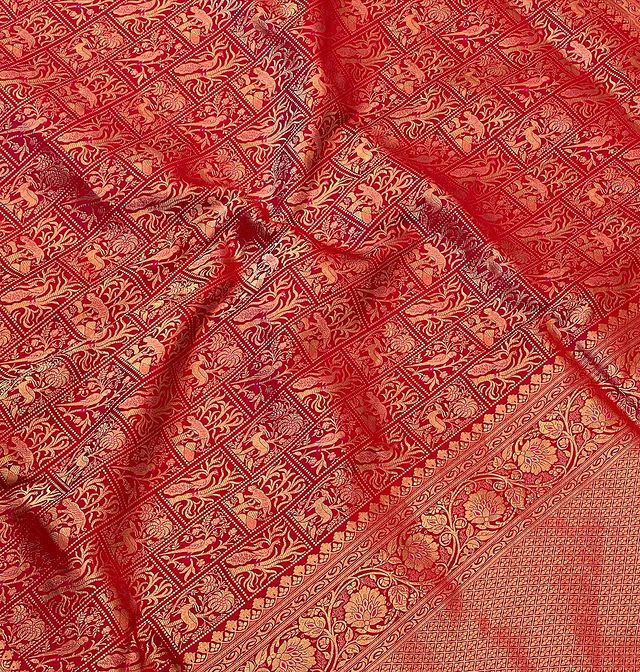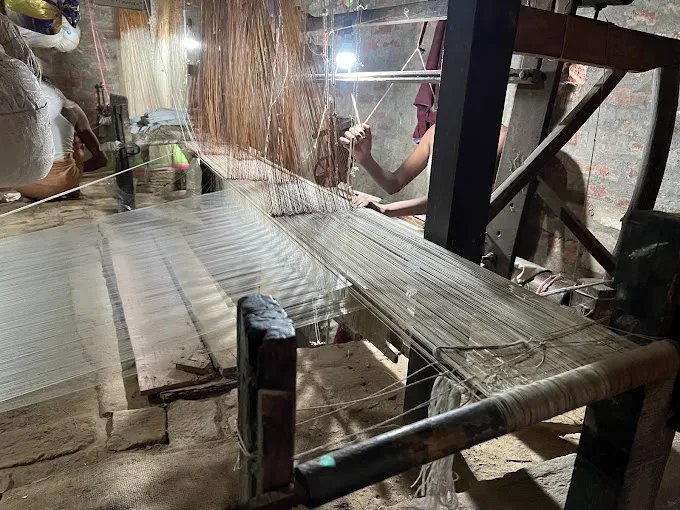Meenakari designs came into use in India during the Mughal era, as a form of embellishment for metal objects such as jewelry and utensils. The technique eventually spread to textiles, including sarees, and became a popular form of decoration.
The process involves applying vivid, intricate designs in gold or silver onto a colored background, typically blue or green. Meenakari is still widely used in India today and is considered an important part of traditional Indian art and culture.
Now, this art style is used to make Banarasi sarees and other outfits. It becomes a stunning design that mesmerises the beholder, especially when coupled with the rich Banarasi weaving.
Cutwork and the hand-weaving method known as kadhwa are both methods that can be used to create Meenakari Banarasi attire including sarees, suits or duppattas The vibrant pattern and style known as meenakari that is woven over Banarasi Silk gives the handloom products a regal appeal.
[Read about the Evergreen Banarasi Sarees]
What is Meenakari?
The terms "Mina" (derived from "Minu"), which means "paradise," and "Kari," which means "to place something onto something else," are combined to make the word "Meenakari," which means paradise or heaven placed onto something. It involves the method of using enamel to paint and colour ceramic and metal surfaces. These designs typically include geometric forms and patterns.
In earlier times, this was mainly crafted on serving dishes, containers, vases, frames, display decorations, and jewellery which frequently have detailed designs added to them as ornamental elements. Iran, India, Afghanistan, and Pakistan are the main countries where this art form is practised.
[Read about Why are Banarasi Sarees popular in India]

How did Meenakari and Banarasi weaves come together?
Meenakari is a form of art that has been practised since the 15th century in Iran, and the term itself is a lovely description of the beauty of this art form. In Iran, during the eighteenth and nineteenth centuries, the craft was at its pinnacle. Iranian meenakari artisans were invited to other countries in the 20th century to help with the training of local artisans.
This style of painting was introduced to India by the Mughals in the 16th century, and everyone was smitten by the craft, which invited various craftsmen to learn and practice. This style uses multiple coloured threads together to make beautiful and colourful motifs.
Varanasi is renowned for being the largest hub for handicraft in textiles in the country. When meenakari designs on garments like sarees and duppattas were popular, the weavers and craftsmen were trained in this type of fashion. This opened the door for meenakari designs on Banarasi fabrics, which created an exquisite work of art that was well-praised.
How are Meenakari Banarasi outfits made?
In order to create a stunning, enduring outfit, each stage in the creation of a Meenakari Banarasi attire takes a great level of talent, perseverance, and meticulous attention to detail.
The process of manufacturing Meenakari Banarasi outfits involves several stages, including:
- Designing: The first step is to come up with a design, which can be inspired by traditional motifs, such as flowers, paisleys, or birds.
- Weaving: The Banarasi fabric is woven on a handloom, using fine silk yarns. The weaver leaves some areas of the fabric blank, where the Meenakari work will be applied later.
- Meenakari: After the fabric is woven, the Meenakari work begins. An artisan first outlines the design on the fabric using a pencil and then applies a layer of enamel paint in the desired color.
- Gilding: Next, a layer of gold or silver foil is applied over the enamel paint, using a special adhesive. The foil is then burnished to create a smooth surface and enhance the design's shine.
- Dyeing: The fabric is then dyed in the desired color, typically blue or green, to create a contrasting background for the Meenakari work.
- Finishing: Finally, the Banarasi outfit is finished and ready to wear.
A meenakari saree uses multiple threads of silk or zari which result in multiple coloured motifs. The sarees made in Banaras can be made with up to twenty or more colours. Both the cutwork and kadhwa weaving techniques can be used to create Meenakari Banarasi sarees.
The whole process requires a lot of labour and takes 10 to 14 days to complete especially in the case of saree. Only on a handloom is it possible to incorporate several colours; it cannot be done on a power loom.
The Meenakari work adds a rich, decorative element to the fabric, making it a luxurious and highly sought-after item of clothing.
Final Thoughts
Meenakari is an art form which beautifully resembles the meaning of its name on the outfit. An exceptional masterpiece is created using the exquisite beauty of Meenakari designs incorporated with rich Banarasi weaves. It creates an absolute pinnacle of beauty and gives every ensemble made in this style a touch of luxury.
Get absolutely stunning meenakari banarasi sarees, duppattas, suits from Albeli. You'll love to show off our gorgeous banarasi dresses from us, which are available in a variety of sheer fabrics, vibrant colours and intricate weaving techniques. Use these stunning outfits to achieve your desire to dress as a princess.






Comments
Leave A Comment: